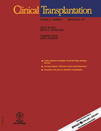Serum phosphate and outcome at one year after deceased donor renal transplantation
Conflict of interest: None.
Abstract
Stevens KK, Morgan IR, Patel RK, Geddes CC, Mark PB, Jardine AG, Delles C. Serum phosphate and outcome at one year after deceased donor renal transplantation. Clin Transplant 2011: 25: E199–E204. © 2011 John Wiley & Sons A/S.
Abstract: Traditional risk factors do not adequately explain the increased prevalence of cardiovascular disease in renal patients. This study considered a “non-traditional” risk factor, serum phosphate and outcome in renal transplant recipients. Data from 377 patients who received a first deceased donor renal transplant between January 1, 1999, and December 31, 2008, were recorded; 10% (n=38) had diabetes, 16.7% (n=63) were smokers, and 18.8% (n=71) had a history of vascular disease. Three hundred and thirty-three patients were alive at the time of the analysis. Survivors were significantly younger, less likely to be smokers or diabetic, and had a higher estimated glomerular filtration rate at one yr post-transplantation. Serum phosphate was significantly lower in these patients (0.95±0.23 vs. 1.04±0.26, p=0.031). Analysis of recipient survival, stratified by serum phosphate at one yr post-transplant, revealed that serum phosphate >1.11 mMol/L was a significant predictor of all-cause mortality (p=0.006). Serum phosphate between 0.9 and 1.11 mMol/L afforded the best outcome. In multivariate analysis, serum phosphate remained a significant predictor of mortality (p=0.016). Serum phosphate at one yr after transplant seems to have a J-shaped relationship with mortality, and this effect is independent of traditional cardiovascular risk factors.




